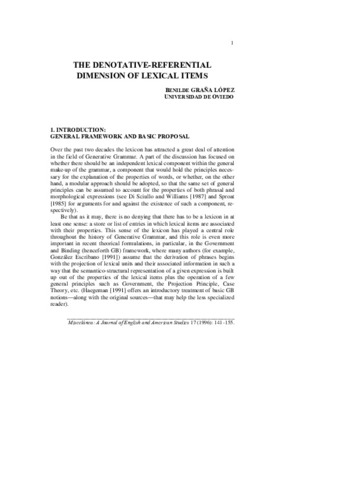The denotative-referential dimension of lexical items
Autor(es) y otros:
Fecha de publicación:
Editorial:
Universidad de Zaragoza
Citación:
Descripción física:
Resumen:
This paper defends the hypothesis that, along with the notion of Argument Structure, which encodes the lexical-conceptual properties of lexical predicates (i.e. the idea that the verb eat, for instance, takes two arguments, an Agent--the eater--and a Theme--the thing that is eaten--as shown in Peter ate the pizza), there is a second dimension to the meaning of lexical items. This level, which we call Denotative-Referential Structure, is concerned with the way words are embedded in the larger syntactic context (i.e. the phrase) that contains them, and are referentially constrained within that context. It is argued that this dimension must be kept separate from Argument Structure both technically and conceptually. The general theoretical framework is that of Generative Grammar and more specifically the set of assumptions that constitute Government and Binding Theory.
This paper defends the hypothesis that, along with the notion of Argument Structure, which encodes the lexical-conceptual properties of lexical predicates (i.e. the idea that the verb eat, for instance, takes two arguments, an Agent--the eater--and a Theme--the thing that is eaten--as shown in Peter ate the pizza), there is a second dimension to the meaning of lexical items. This level, which we call Denotative-Referential Structure, is concerned with the way words are embedded in the larger syntactic context (i.e. the phrase) that contains them, and are referentially constrained within that context. It is argued that this dimension must be kept separate from Argument Structure both technically and conceptually. The general theoretical framework is that of Generative Grammar and more specifically the set of assumptions that constitute Government and Binding Theory.
ISSN:
Colecciones
- Artículos [37556]
- Filología Inglesa, Francesa y Alemana [591]
Ficheros en el ítem




